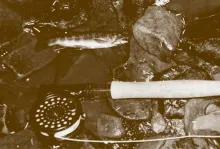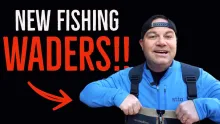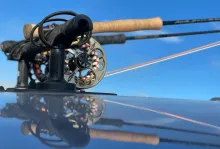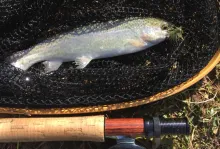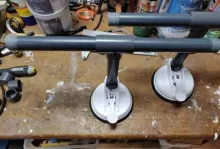Light gear is best for little fish for two big reasons: first, light or ultralight outfits provide the most sport by giving these fish their best fighting chance; second, lighter outfits make fly fishing possible in unforgiving casting situations that leave little room for human error.
Fly fishing is a personal activity that gives men and women the chance to express their personality and preferences while in action out in the open. There is no authoritative “How To” in the great crowded universe of fishing gear, but a few guidelines are useful when beginning the angling odyssey, or when branching out into another facet of the sport such as the pursuit of little fins on the fly.
Small Fry Outfits
Light gear is best for little fish for two big reasons: first, light or ultralight outfits provide the most sport by giving these fish their best fighting chance; second, lighter outfits make fly fishing possible in unforgiving casting situations that leave little room for human error.
Time and technology have resulted in enough fishing gear choices to fill a shopping mall as well as your independent fly shop. There are now even 1-weight fly rod and reel outfits available. The most useful gear for little fish is a little larger: seven- to nine-foot, 3- to 5-weight combos are ideal. Options abound, and a well-stocked fly fishing emporium should resemble the cereal aisle of a supermarket. My advice: shop around, and settle on the brand name you yourself endorse and that makes you feel most confident. Good luck along the water is a matter of confidence as much as it is a matter of chance.
A short stick is handy in some narrow situations such as shallow streams with high, brushy banks. I have found that a longer rod is better for general little fishing. Oftentimes success requires the ability to place a fly in tight spots, like when high stick nymphing, and a longer rod makes this a happy fact rather than a headache. Dapping a dry fly into an eddy lined with flotsam and fishing in pocket water surrounded by alders will make you swear less when the length of a longer rod is used to its advantage.
The classic 8 1/2-foot, 5-weight outfit has been my choice for years. As basic as it is, it works. Good reputations are built on consistency, and for my (limited) money, “Old 8 1/2” always meets my expectations.

Small Fry Flies
There is an inherent irony surrounding the topic of fly patterns for small fish. Native brook trout and panfish will almost always require diminutive-sized patterns, but the largest possible ties of wet and dry trout flies best lure big redbreast sunfish and small smallmouth bass.
One commonality is that all of these fish rise most readily to attractor patterns. Fuzzy hackles, rubber legs, and gaudy colors are a sure bet. Small fish possess a truckload of curiosity, yet lack one important quality the majority of large fish share, and that is patience. Like hungry children, small fish don’t want to wait. There are a variety of reasons for this. Native brook trout tend to reside in tannic, somewhat sterile, freestone streams with limited resident insect life. Impatience on their part is driven by the need to be opportunistic. Any mosquito, ant, beetle, or cricket that slips and falls into the creek will meet its doom if a brook trout is finning stealthily in close proximity. Panfish usually reside in more fertile water and so have a different motive. Like pugnacious grade school bullies, they are often the prey themselves, but quick to gang up on something -- a minnow, crayfish, nymph, or terrestrial insect -- less than its own size.
Master craftsmen like Bob Clouser, Harry Murray, John Shewey, and Dave Whitlock are true artisans who take the art of thread, feather, and hook to its highest level. Meanwhile, folks like me master the basics and tie a couple dozen flies a few times a year, usually during early spring or the week before a big trip. My example illustrates the fact that general patterns for small fry provide a fine introductory course for the novice and a relaxing diversion for the expert. The fly patterns of my own design, sprinkled throughout this narrative, consist of simple materials and basic tying techniques and can all be used to pursue the lure of the little with success. To summarize, here are my home-cooked recipes:
Easy & Orange
Hook: standard wet fly, size 10 to 16
Thread: 8/0 black
Body: orange floss
Hackle: pheasant tail
Gray Wool Nymph (Swegman’s Special)
Hook: standard nymph, size 10 to 16
Thread: 8/0 black
Tail: pheasant tail
Body: gray baby ull knitting wool
Green Guarantee
Hook: standard streamer, size 8 to 14
Thread: 8/0 green
Tail (optional): pheasant tail
Body: green thread
Rib: green floss
Beard: pheasant tail
Wet Wool Adams
Hook: standard dry fly, size 10 to 16
Thread: 8/0 black
Tail: pheasant tail
Body: gray baby ull knitting wool
Wing: pheasant tail
Simple materials, easy ties, good flies. Plan accordingly for the species you wish to target. Give your own tying vice a good workout, or your fly shop owner good business, and you will be prepared to attract fish.

Small Fry Extras
The single-most important small fish extra is a good fishing vest. Tackle boxes and coolers are too noisy and cumbersome to carry in small, often steep, natural settings. Fishing accessories and even a sandwich or two can be carried in a vest, or a vest augmented by a small satchel or fanny pack. Many outfitters offer several styles from “simple” to “kitchen sink” that have plenty of pocket room. A basic vest in the thirty- to fifty-dollar range is best. The fabric will receive a lot of wear and tear in the wild.
A poem should be written in celebration of the worn fishing vest, in fact a complete history, if one has not been penned already. Sentimentality aside, the fishing vest is a mnemonic device for keeping one’s angling memory banks intact. That tear on the left shoulder seam -- caused by the overhanging branch beneath which a four-pound brown trout later met your nymph -- such associations put the truth into the fun show and tell fish story that will entertain both new acquaintances and old buddies along the water.
A good vest is the key accessory for general mobility, and when going mobile, nothing beats a sturdy mountain bike. I have been an “on the fly” cycling angler for years and can cover miles of creek or lakeshore in a day with relative ease and comfort. If I reach a favorite spot and someone already happens to be there -- no problem -- I can pedal upstream along the little angler’s path, park with ease by leaning the bike against a sturdy tree, and then match wits with even wilder and larger trout.
Cycling along a stream most often affords a God's eye view of the water. This bonus arises from the fact that bike paths usually follow former rail lines or are part of a broader recreational trail that flanks a creek. This vantage point allows an angler to read the water well, which makes scouting a less rigorous exercise than the actual descent to and ascent from the water. Bike trails often spread out and meet prime spots for "putting in" to a stream. These are the shallow riffles, the wrinkled water, the transition zones marking the end of one pool and the beginning of another. Here also are good spots for practicing the tactic made famous by the Edwardian era fly fisher and author George M. L. La Branche -- the dry fly in fast water.
Mountain bikes are easy to transport if you first have to take to the highway. Safe commercial racks are available for both the hood and trunk of a four-wheel vehicle. If you happen to own a pickup, simply loading it securely in back can inexpensively carry the bike. Once at the water, you can either carry the rod in a custom rod tube that attaches to the front tire rail, or else attach it in its regular tube to the main bike frame with one or two bungee cords wrapped in a secure spiral pattern from front to back.
Little waters allow anglers young and old to explore. Half the fun of fishing small is the flora and fauna that can be seen and heard up close along less-pressured water. A pair of binoculars, a magnifying glass, a topographical map, and a field guide or two can add general nature study to the fun of a fishing outing. Parents can take pride when their children ask the eternal question: “What’s that?” -- and they can answer, correctly.
If you greet the small fish and its lair with the correct gear, scaled down and designed for mobility and exploration, you shall succeed, not a little, but a lot.

- Log in to post comments


